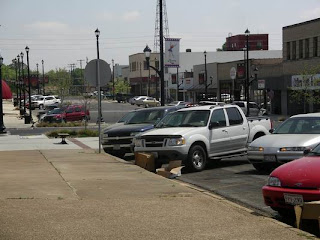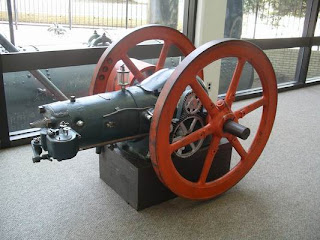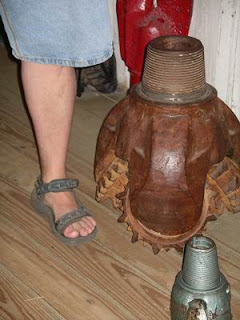After visiting the Oil Boom museum we headed to 'downtown' Kilgore to see the 'world's richest acre'. This is a 1.192 acre of land in downtown Kilgore that was first drilled in 1937. Developed before the spacing laws, this parcel of land held 24 oil wells on 10 lots owned by six different operators. The acre has produced over 2.5 million barrels of oil.
1000 oil derricks covered downtown Kilgore for many years making it the most concentrated area of derricks in the world. Most of the derricks have now been removed but in a push to 'honor' their history several derricks have been reconstructed in downtown Kilgore creating the small park "World's Richest Acre". There is a huge lighting ceremony at Christmas that highlights these derricks.
There are over 17,000 oil wells still active in the East Texas oil field. Geologists say that there is oil for at least another 45 years. One, thing I thought was interesting we learned at the museum was that under all the oil is a huge salt water reservoir and while they pumped out the oil, they also pumped out millions of gallons of this salt water. At the time (1930's) they just emptied the water into the streams and forests, etc around the wells. Then (luckily for the environment I suppose!!) they discovered that the salt water reservoir provided pressure in order to more easily extract the oil, as they removed it, the pressure dropped and so did the oil level. To fix this issue, a new company was created to dispose of this salt water - The East Texas Salt Water Disposal Company. They figured out how to pump the water back to where it came from thus restoring the pressure at the wells and the need to dump it on the surface killing thousands of acres of plants and animals.
Heading to the World's Richest Acre
The derricks in the background are replica's of the
ones that stood there since the 1930's.
The derricks at the World's Richest Acre Park
It was like a metal forest!!
Click to enlarge & read about the
World's Richest Acre
Kilgore, TX Train Depot
Downtown Kilgore
On our way back from Kilgore we drove through several East Texas towns including Henderson & Jacksonville. Just outside of Jacksonville, TX along Hwy 69 heading back to Tyler we stumbled onto this roadside rest area. It was quite beautiful and afforded some great views of the East Texas country side. We had no idea that we'd actually climbed/drove on top of a hill so the views were quite unexpected!! Hannah & Maggie loved getting out and stretching their legs and we enjoyed the green.
There was a wedding (now I've seen it all - a wedding at a rest area) taking place near the rest area view point so we didn't intrude but it was a lovely stop. Below are a few photos from the rest area.
The Happy Couple having their photos made






















































